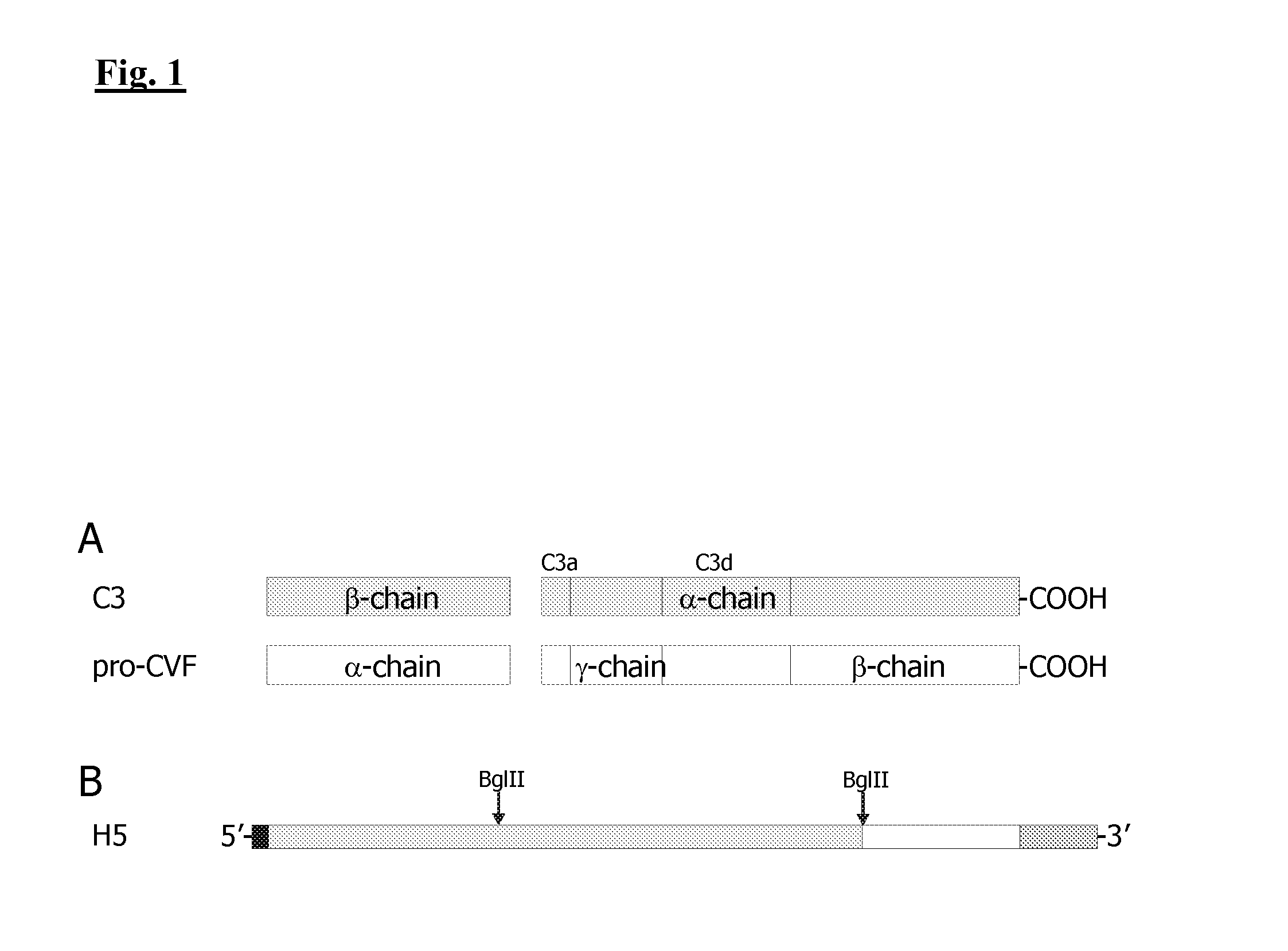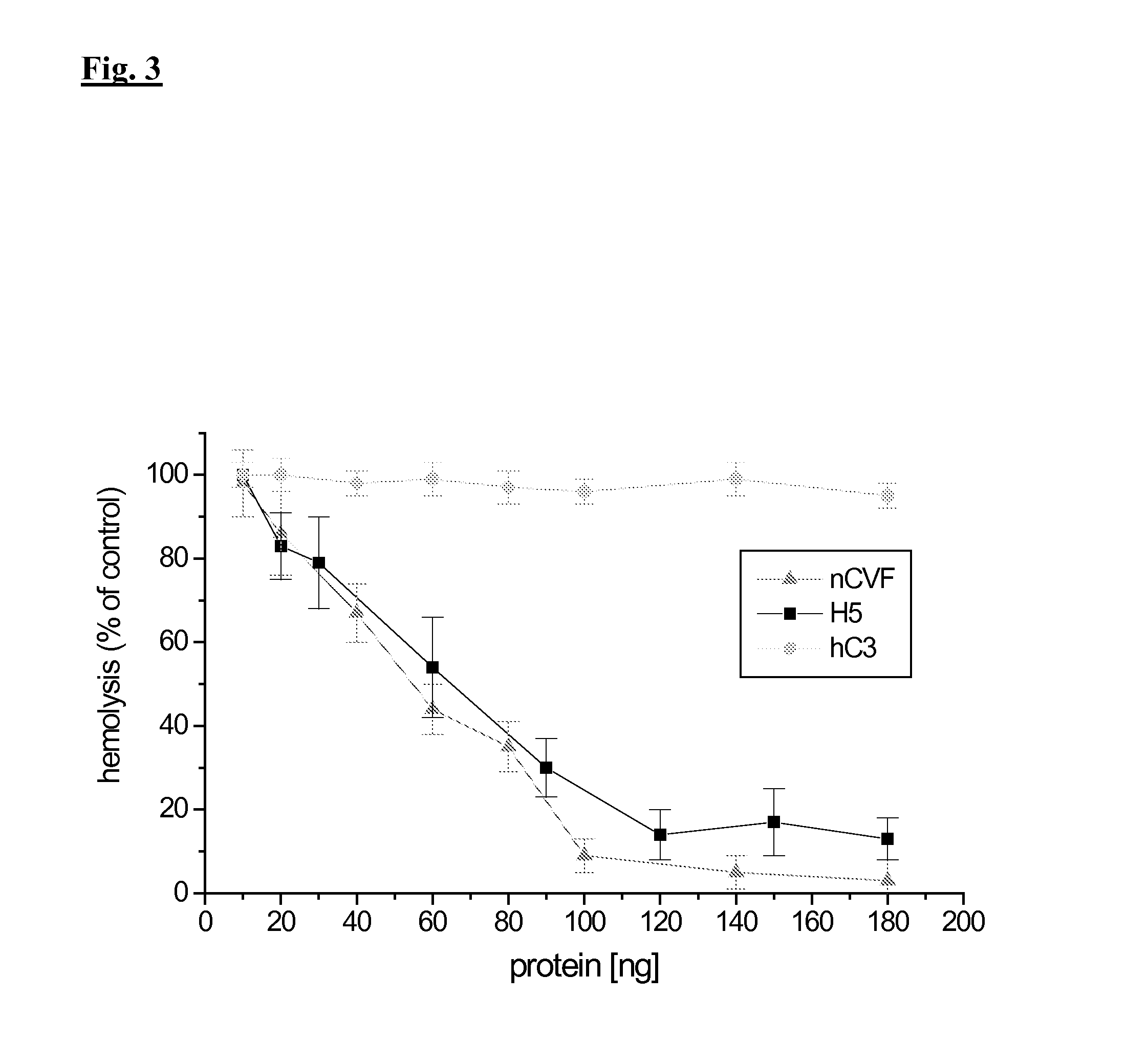Controlled activation of complement components for use as endogenous adjuvant
a technology of endogenous adjuvant and complement, which is applied in the direction of snake antigen ingredients, carrier-bound antigen/hapten ingredients, antibody medical ingredients, etc., can solve the problems of poor adjuvant effect of polysaccharide antigen, inability to induce th1 antibody isotypes or cellular, and generally far less immunogenicity, so as to effectively stimulate the immune response
- Summary
- Abstract
- Description
- Claims
- Application Information
AI Technical Summary
Benefits of technology
Problems solved by technology
Method used
Image
Examples
example 1
Analysis of Complement Activation
1.1. Preparation of Sensitized Sheep Erythrocytes
[0209]Sheep whole blood (1 ml, Behringwerke, Marburg) is resuspended in 13 ml cold GVBS++ and centrifuged for 10 min at 1,000×g (4° C.). The supernatant is removed and the erythrocytes are again resuspended in 14 ml GVBS++. This procedure is repeated until a clear supernatant is obtained. Subsequently, the erythrocytes are resuspenden in approx. 5 ml GVBS++. Erythrocytes are adjusted by dilution with GVBS++ to give an absorption of 1.9 at 412 nm for 30 μl erythrocyte suspension in 1 ml H2O corresponding to a density of 5×108 cells / ml. After the addition of 2 μl antiserum against sheep erythrocytes (anti sheep red blood cell stroma, Sigma, Taufkirchen) per ml of the adjusted erythrocytes, sensitizing is performed for 1 h in a water bath at 37° C., while inverting the reaction tube regularly after 10 min. The sensitized erythrocytes are washed three times with 2 ml GVBS++ and centrifuged for 3 min at 1,0...
example 2
Tissue Culture and Recombinant Expression
2.1. Cell Culture
[0222]COS-7 cells, HEK293 and CHO cells are cultured in an incubator (Heraeus Instruments Begasungsbrutschrank 6060) in a water saturated atmosphere (5% CO2) at 37° C. Growth is performed in DMEM medium (Gibco / BRL, Eggenstein, Germany) which is supplemented with 10% fetal calf serum (Biochrom, Berlin, Germany). As soon as cells grow confluently in the tissue culture flasks (75 cm3, Cellstar, Greiner Labortechnik, Frickenhausen, Germany), they are passaged into a new culture flask (approximately every 3 days). The cell supernatant is removed and the cells are washed with phosphate-buffered saline. After the addition of 4 μl trpysin / EDTA (Gibco BRL, Eggenstein, Germany), cells are incubated for 5 min in an incubator. Detachment of the cells from the bottom is suported by gentile shaking and is controlled under the microscope. When the cells are almost completely detached, the procedure is stopped by adding 8 ml serum-containing...
example 3
Expression and Purification of CVF and Human C3
[0236]For the expression of CVF plasmids pUC18CVF and pcDNA3CVF (both contain the cDNA of CVF; Genebank Accession No. U09969) were employed and for the expression of human C3 plasmids pUC18hC3 and pcDNA3hC3 according to U.S. Pat. No. 7,553,931 B2. The expression of recombinant CVF and human C3 was performed as described in Example 2.
[0237]For analyses via solid-phase-assays a Strep-tagII sequence was fused to the N-terminus of both molecules. Using the CVF-cDNA two amplification products were generated in two PCR reactions and the amplification products were hybridized by PCR as described in U.S. Pat. No. 7,553,931 B2. Furthermore, an enterokinase-cleavage site was inserted into the cDNA of CVF and human C3 between the signal sequence and the N-terminus of the Strep-tagII to allow for cleavage of the affinity tag.
[0238]For separation of low molecular components of the culture supernatants or column fractions, the supernatants or fractio...
PUM
| Property | Measurement | Unit |
|---|---|---|
| gelling temperature | aaaaa | aaaaa |
| gelling temperature | aaaaa | aaaaa |
| molecular weight | aaaaa | aaaaa |
Abstract
Description
Claims
Application Information
 Login to View More
Login to View More - R&D
- Intellectual Property
- Life Sciences
- Materials
- Tech Scout
- Unparalleled Data Quality
- Higher Quality Content
- 60% Fewer Hallucinations
Browse by: Latest US Patents, China's latest patents, Technical Efficacy Thesaurus, Application Domain, Technology Topic, Popular Technical Reports.
© 2025 PatSnap. All rights reserved.Legal|Privacy policy|Modern Slavery Act Transparency Statement|Sitemap|About US| Contact US: help@patsnap.com



